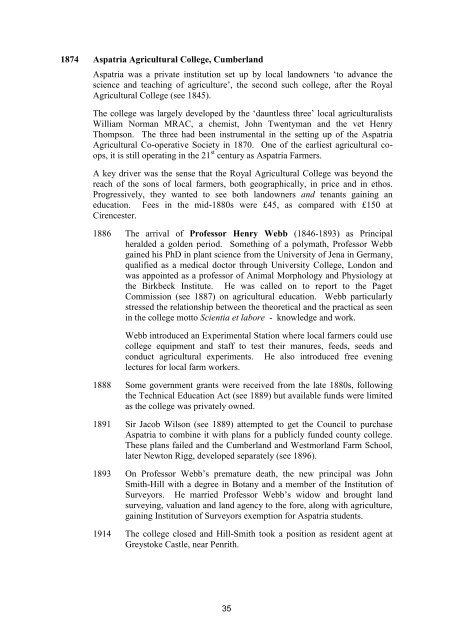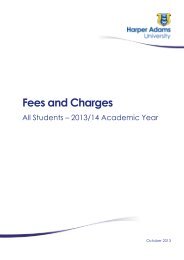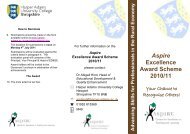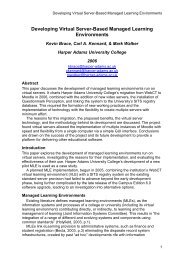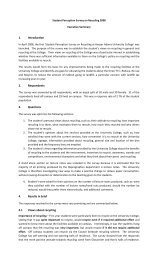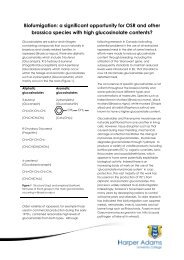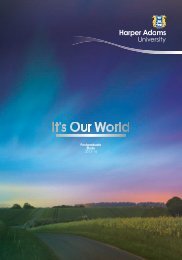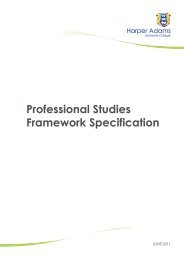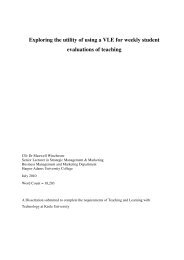a short history of agricultural education and research
a short history of agricultural education and research
a short history of agricultural education and research
Create successful ePaper yourself
Turn your PDF publications into a flip-book with our unique Google optimized e-Paper software.
1874 Aspatria Agricultural College, Cumberl<strong>and</strong>Aspatria was a private institution set up by local l<strong>and</strong>owners ‘to advance thescience <strong>and</strong> teaching <strong>of</strong> agriculture’, the second such college, after the RoyalAgricultural College (see 1845).The college was largely developed by the ‘dauntless three’ local <strong>agricultural</strong>istsWilliam Norman MRAC, a chemist, John Twentyman <strong>and</strong> the vet HenryThompson. The three had been instrumental in the setting up <strong>of</strong> the AspatriaAgricultural Co-operative Society in 1870. One <strong>of</strong> the earliest <strong>agricultural</strong> coops,it is still operating in the 21 st century as Aspatria Farmers.A key driver was the sense that the Royal Agricultural College was beyond thereach <strong>of</strong> the sons <strong>of</strong> local farmers, both geographically, in price <strong>and</strong> in ethos.Progressively, they wanted to see both l<strong>and</strong>owners <strong>and</strong> tenants gaining an<strong>education</strong>. Fees in the mid-1880s were £45, as compared with £150 atCirencester.1886 The arrival <strong>of</strong> Pr<strong>of</strong>essor Henry Webb (1846-1893) as Principalheralded a golden period. Something <strong>of</strong> a polymath, Pr<strong>of</strong>essor Webbgained his PhD in plant science from the University <strong>of</strong> Jena in Germany,qualified as a medical doctor through University College, London <strong>and</strong>was appointed as a pr<strong>of</strong>essor <strong>of</strong> Animal Morphology <strong>and</strong> Physiology atthe Birkbeck Institute. He was called on to report to the PagetCommission (see 1887) on <strong>agricultural</strong> <strong>education</strong>. Webb particularlystressed the relationship between the theoretical <strong>and</strong> the practical as seenin the college motto Scientia et labore - knowledge <strong>and</strong> work.Webb introduced an Experimental Station where local farmers could usecollege equipment <strong>and</strong> staff to test their manures, feeds, seeds <strong>and</strong>conduct <strong>agricultural</strong> experiments. He also introduced free eveninglectures for local farm workers.1888 Some government grants were received from the late 1880s, followingthe Technical Education Act (see 1889) but available funds were limitedas the college was privately owned.1891 Sir Jacob Wilson (see 1889) attempted to get the Council to purchaseAspatria to combine it with plans for a publicly funded county college.These plans failed <strong>and</strong> the Cumberl<strong>and</strong> <strong>and</strong> Westmorl<strong>and</strong> Farm School,later Newton Rigg, developed separately (see 1896).1893 On Pr<strong>of</strong>essor Webb’s premature death, the new principal was JohnSmith-Hill with a degree in Botany <strong>and</strong> a member <strong>of</strong> the Institution <strong>of</strong>Surveyors. He married Pr<strong>of</strong>essor Webb’s widow <strong>and</strong> brought l<strong>and</strong>surveying, valuation <strong>and</strong> l<strong>and</strong> agency to the fore, along with agriculture,gaining Institution <strong>of</strong> Surveyors exemption for Aspatria students.1914 The college closed <strong>and</strong> Hill-Smith took a position as resident agent atGreystoke Castle, near Penrith.35


